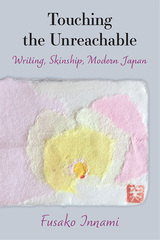2 books about Touch in literature

Home Bodies
Tactile Experience in Domestic Space
James Krasner
The Ohio State University Press, 2010
How do acts of caring for the sick or grieving for the dead change the way we move through our living rooms and bedrooms? Why do elderly homeowners struggle to remain in messy, junk-filled houses? Why are we so attached to our pets, even when they damage and soil our living spaces? In Home Bodies: Tactile Experience in Domestic Space, James Krasner offers an interdisciplinary, humanistic investigation of the sense of touch in our experience of domestic space and identity. Accessing the work of gerontologists, neurologists, veterinarians, psychologists, social geographers, and tactual perception theorists to lay the groundwork for his experiential claims, he also ranges broadly through literary and cultural criticism dealing with the body, habit, and material culture.
By demonstrating crucial links between domestic experience and tactile perception, Home Bodies investigates questions of identity, space, and the body. Krasner analyzes representations of tactile experience from a range of canonical literary works and authors, including the Bible, Sophocles, Marilynne Robinson, Charles Dickens, John Steinbeck, and Sylvia Plath, as well as a series of popular contemporary texts. This work will contribute to discussions of embodiment, space, and domesticity by literary and cultural critics, scholars in the medical humanities, and interdisciplinary thinkers from multiple fields.
[more]

Touching the Unreachable
Writing, Skinship, Modern Japan
Fusako Innami
University of Michigan Press, 2021
Fusako Innami offers the first comprehensive study of touch and skinship—relationality with the other through the skin—in modern Japanese writing. The concept of the unreachable—that is, the lack of characters’ complete ability to touch what they try to reach for—provides a critical intervention on the issue of intimacy. Touch has been philosophically addressed in France, but literature is an effective—or possibly the most productive—venue for exploring touch in Japan, as literary texts depict what the characters may be concerned with but may not necessarily say out loud. Such a moment of capturing the gap between the felt and the said—the interaction between the body and language—can be effectively analyzed by paying attention to layers of verbalization, or indeed translation, by characters’ utterances, authors’ depictions, and readers’ interpretations. Each of the writers discussed in this book—starting with Nobel prize winner Kawabata Yasunari, Tanizaki Jun’ichirō, Yoshiyuki Junnosuke, and Matsuura Rieko—presents a particular obsession with objects or relationality to the other constructed via the desire for touch.
In Touching the Unreachable, phenomenological and psychoanalytical approaches are cross-culturally interrogated in engaging with literary touch to constantly challenge what may seem like the limit of transferability regarding concepts, words, and practices. The book thereby not only bridges cultural gaps beyond geographic and linguistic constraints, but also aims to decentralize a Eurocentric hegemony in its production and use of theories and brings Japanese cultural and literary analyses into further productive and stimulating intellectual dialogues. Through close readings of the authors’ treatment of touch, Innami develops a theoretical framework with which to examine intersensorial bodies interacting with objects and the environment through touch.
In Touching the Unreachable, phenomenological and psychoanalytical approaches are cross-culturally interrogated in engaging with literary touch to constantly challenge what may seem like the limit of transferability regarding concepts, words, and practices. The book thereby not only bridges cultural gaps beyond geographic and linguistic constraints, but also aims to decentralize a Eurocentric hegemony in its production and use of theories and brings Japanese cultural and literary analyses into further productive and stimulating intellectual dialogues. Through close readings of the authors’ treatment of touch, Innami develops a theoretical framework with which to examine intersensorial bodies interacting with objects and the environment through touch.
[more]
READERS
Browse our collection.
PUBLISHERS
See BiblioVault's publisher services.
STUDENT SERVICES
Files for college accessibility offices.
UChicago Accessibility Resources
home | accessibility | search | about | contact us
BiblioVault ® 2001 - 2024
The University of Chicago Press









